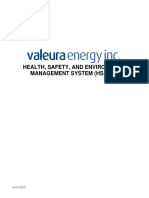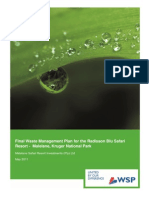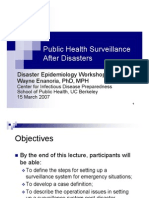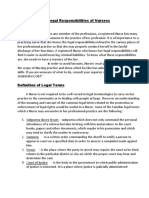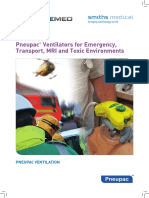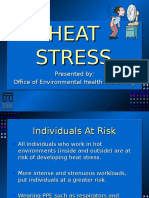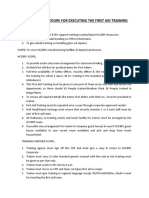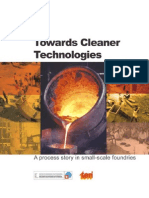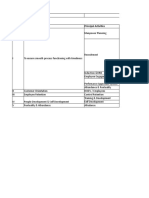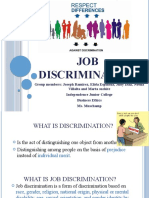Garispanduan7 DOSH First Aid
Garispanduan7 DOSH First Aid
Uploaded by
drstein1974Copyright:
Available Formats
Garispanduan7 DOSH First Aid
Garispanduan7 DOSH First Aid
Uploaded by
drstein1974Copyright
Available Formats
Share this document
Did you find this document useful?
Is this content inappropriate?
Copyright:
Available Formats
Garispanduan7 DOSH First Aid
Garispanduan7 DOSH First Aid
Uploaded by
drstein1974Copyright:
Available Formats
GUIDELINES ON FIRST-AID IN THE WORKPLACE
(2nd Edition)
DEPARTMENT OF OCCUPATIONAL SAFETY AND HEALTH MINISTRY OF HUMAN RESOURCES MALAYSIA 2004
JKKP : ISBN :
GP(I) 06 / 2004 983-2014-43-3
PREFACE
First-aid is the assessment and interventions that can be performed by a first aider during an emergency with minimal equipment until appropriate medical personnel arrive. The life of an injured or ill worker or member of the public within the vicinity of the workplace may depend on proper first-aid being given within the first few minutes of an accident or an illness. Besides saving lives, first-aid treatment is important in preventing further complications from injury and pain and in promoting recovery. It is also important for minor injuries such as burns, sprains, cuts, etc. This guidelines help employers, occupiers and Occupational Safety and Health personnel, to plan and provide proper first-aid facilities in factories or other workplaces. It is presented in a simple format for quick and easy reference. It is hoped that it will meet the needs of industry.
ACKNOWLEDGEMENT. Department of Occupational Safety and Health (DOSH) Malaysia is grateful for the valued input and content recommendations from the following contributors for the second edition of this guidelines: Prof. Dr. Krishna Gopal Rampal Senior Lecturer of Occupational Health Medical Faculty University Kebangsaan Malaysia. Dr. Abu Hassan Samad Medical Adviser Exonmobil Malaysia. Dr. Nik Hisamuddin Nik Ab. Rahman. Lecturer of Emergency Medicine School of Medical Sciences University Science Malaysia Dr. Agus Salim Mohd. Banon Manager Occupational Health Division. NIOSH Dr. Jefferelli Shamsul Bahrin Occupational Health Physician, BASF PETRONAS Chemicals Sdn. Bhd. Dr. Faridah Amin Occupational Health Physician Industrial Health Division DOSH, Headquarters. Dr. Norsayani Mohd. Yaacob. Occupational Health Physician DOSH, Pahang. Mr. Haniff Yahaya Executive Occupational Health Division. NIOSH Dr. Siah Chui Khim Master Student Social Preventive Medicine University Malaya. Mr. Mohamad Husain Sajahan. Lead Paramedic BASF PETRONAS Chemicals Sdn. Bhd.
DOSH also acknowledge and appreciate the prior hard work, dedication, and foundation provided by the editors of the prior edition, Dr. Abed Onn, Dr. Ling Kin Hong, Mr. D. Muniady, Major(R) Raja Harun Raja Ismail, Dr. Rosidah Ibrahim, Dr. Sarfuddin Osman, Hjh. Maimunah Khalid, Dr. Sarojiji S, Ir. Hj. Abu Bakar Che Man, Ir. Mohtar Musri, Mr. Anuar Mokhtar and Mdm. Muaziah Abd. Rahman, and the many users of the Guides who submitted recommendations concerning the revision. Their input was essential to creating this edition of Guides.
Ir. Hj. Abu Bakar Che Man Director General DOSH, Malaysia.
Ir. Hj. Zainuddin Abdullah Deputy Director General DOSH, Malaysia.
Table of Content Page 1. 2. 3. DEFINITIONS LEGAL PROVISION COMPONENTS OF WORKPLACE FIRST-AID FACILITIES 3.1 Major Components 3.2 Factors to Consider FIRST-AIDERS 4.1 Number Required 4.1.1 General Guide 4.1.2 Shift Work 4.1.3 Work-site With More Than One Employer 4.2 Provision of Information about First-Aiders 4.3 Selection 4.4 Training 4.4.1 Recognized Course 4.4.2 The Need for Further Training 4.4.3 Training Record 4.5 Responsibilities 4.5.1 Management Of Casualty 4.5.2 Maintenance Of Treatment Record 4.5.3 Responsibilities For Maintenance Of First-Aid Facilities FIRST-AID BOX 5.1 Design 5.2 Location 5.3 Contents FIRST-AID ROOM 6.1 Design 6.2 Location 6.3 Items In First-Aid Room SPECIAL FIRST AID REQUIREMENTS 7.1 Provision For Mass Casualties 7.2 Special Instructions 7.3 Protective Clothing And Equipment 7.4 Cleaning Up REFERENCES Appendix 1 Institutions Recognized by the DOSH for providing training on First-Aid in the Workplace Appendix 2 Course Content for First-Aider Appendix 3 Record of Casualty and Treatment given by First-Aider Appendix 4 Recommended Content of First-Aid Box Appendix 5 Checklist for Components of First-Aid requirements Appendix 6 Checklist For First-Aid Box Appendix 7 Typical Layout Of A First-Aid Room Appendix 8 Recommended Facilities For First-Aid Room 1 2 2 2 2 2 3 3 3 3 3 3 4 4 4 5 5 5 5 6 6 6 7 7 7 7 7
4.
5.
6.
7.
8.
9 10 12 13 14 15 16 17
Guidelines On First-Aid In Workplace
1.
DEFINITIONS 1.1 First-aid in the workplace includes the provision of first-aid facilities, services and personnel required for the initial treatment of persons suffering from injury or illness at a workplace. It is the immediate treatment or care given to a victim of an accident or sudden illness before qualified health personnel attend to provide treatment. The aims of first aid are to: Preserve life; Prevent illness or injury from becoming worse; Reduce pain; Promote recovery; and Care of unconscious. 1.2 First-aid facilities includes first-aid box; first-aid room; and first-aid equipment, e.g. oxygen tanks and stretchers. First-aid requirement means the requirements for first aid facilities, services and personnel at a workplace; First-aid services means any procedure or method associated with the provision of first-aid at the workplace; First-aider means a person who has successfully completed a first-aid course and has been awarded with a certificate of proficiency in first-aid by an institution listed in Appendix 1. Risk means the likelihood that a hazard will cause harm. Universal Precautions means a set of precautions designed to prevent transmission of blood-borne pathogens when providing first aid or health care.
1.3
1.4
1.5
1.6 1.7
2.
LEGAL PROVISION An employer has a duty to provide information, instruction, training and supervision about first aid facilities and services for employees. 2.1 The Factories and Machinery Act 1967 Section 25 of the Factories and Machinery Act 1967 (Act 139) and Regulation 38 of the Factories and Machinery (Safety, Health and Welfare) Regulations 1970 state the scope of responsibility of an occupier with regards to first-aid provision. The scope includes: providing and maintaining a first-aid box or cupboard of such standard as may be prescribed and ensuring the box is readily accessible at all times;
Department of Occupational Safety and Health 1
Guidelines On First-Aid In Workplace
assigning the responsibility to upkeep a first-aid box or cupboard to a responsible person, and for a factory with more than 20 person employed, specifying that the responsible person should be proficient in first-aid treatment; and providing and maintaining a first-aid room in a factory where more than 150 person are employed.
2.2
The Occupational Safety and Health Act 1994 Section 15(1) of the Occupational Safety and Health Act 1994 (Act 514) provides that every employer and the self-employed person must ensure, so far as is practicable, the safety, health and welfare at work of all his employees. The provision of first-aid facilities and first-aiders is in compliance with the welfare component of this general duty of employers and self-employed persons.
3.
COMPONENTS OF WORKPLACE FIRST-AID. 3.1 Major Components There are four major components of workplace first-aid, namely; 3.2 first-aider first-aid box first-aid room first-aid equipment
Factors to Consider When deciding on the number of first-aiders, first-aid box, first-aid room and first-aid equipment for the workplace, the following factors should be considered: type of industry number of workers number of work shifts location of workplace and status of infrastructure in relation to the nearest medical clinic or hospital
Department of Occupational Safety and Health 2
Guidelines On First-Aid In Workplace
4.
FIRST-AIDERS 4.1 Number of first-aiders Required. 4.1.1 General Guide Description a. workplaces with low risk hazards (e.g. office) No. Of Workers less than 20 21- 150 more than 150 No. Of First-aiders one (1) two (2) two (2) for every 150 workers or part thereof. one (1) per shift one (1) for every 20 workers or part thereof.
b. workplaces with high risk hazards (e.g. chemical plant, shipyards, construction sites) c. Workplaces with more than 400 workers
less than 20 20 or more
two (2) for every 150 workers or part thereof and in addition a registered nurse or medical assistant must be employed on site. one for every tree felling gang**
d. Logging
** a tree-felling gang is a group of workers involved in tree felling operation which normally consists of a tree-feller, a tractor driver, a wireman and the supervisor.
4.1.2 Shift Work If there is a shift work schedule, there should be a sufficient number of firstaiders for each shift based on the guideline in paragraph 4.1.1. 4.1.3 Work-Site With More Than One Employer In a work-site (e.g. a construction site) where employees of different employers are working together, Act 514 requires the principal employer to provide and maintain safe systems of work which include provisions for adequate and appropriate first-aider, first-aid box, first-aid room and first-aid equipment. However, the relevant employers may make arrangement whereby one of them agrees to provide adequate and appropriate first-aider, first-aid box, first-aid room and first-aid equipment to comply with the above guidelines. The agreement should be recorded in writing and a copy of the agreement should be kept by each employer concerned.
Department of Occupational Safety and Health 3
Guidelines On First-Aid In Workplace
4.2
Provision of Information About First-Aiders An employer should display a notice, in a prominent place in the work-site, of the names and locations of first-aiders. First-aiders should also be provided with a form of identification (e.g. badge, arm band) for easy recognition.
4.3
Selection An employer shall, from time to time, recruit or select suitable persons to go for first-aid training. The employer should consider persons with the following qualities to be trained in first-aid: physically fit free from blood borne infectious diseases, e.g. Hepatitis B, HIV/AIDS free to leave their work immediately to respond to an emergency
4.4
Training 4.4.1 Recognised Course A course on first-aid conducted by institutions listed in Appendix 1 are recognized by DOSH as meeting the first-aid training requirement. The course should have contents listed in Appendix 2. 4.4.2 The Need for Refresher Training First-aiders need to undergo a recognized course (appendix 1) once every three (3) years. 4.4.3 Training Record The employers should keep a record of the dates on which first-aiders obtained their training and the dates on which they received refresher training.
4.5
Responsibilities 4.5.1 Management of Casualty In the management of an injured worker or ill worker, first-aiders should: give immediate first-aid treatment, keeping in mind that a casualty may have more serious injuries and illness; and arrange without delay for the injured worker(s) to be sent to a doctor, hospital or home, according to the seriousness of this condition.
Department of Occupational Safety and Health 4
Guidelines On First-Aid In Workplace
Apply the principle of Universal Precautions while delivering the responsibility to protect the first-aiders from acquiring blood borne pathogen e.g. Hepatitis B and HIV.
This first-aiders responsibility ends when the casualties are handed over to the care of health care personnel. 4.5.2 Maintenance of Treatment Record A record of the casualty and treatment given by the first-aider should be made as in Appendix 3. This record shall be kept by the employer for a period of five years. The record should include information on: the immediate treatment; details about the incident/accident including information about the work process involved; details about injury or work-related illness; any referral arrangements made, e.g. usage of local ambulance service, referral to local hospital; and subsequent casualty management.
4.5.3 Responsibilities for Maintenance of First-Aid Requirement. This first-aider is responsible for maintaining the first-aid box. He/She should ensure that only first-aid material is kept inside the box. He/She should check them periodically and ensure that the contents of the box are regularly replenished (as recommended in Appendix 4). However, it must be remembered that the absolute responsibility for maintaining first-aid facilities lies with the employer. Hence, the employer must ensure that the first-aider carries out his/her assigned responsibility. The employer should review annually the first-aid requirement (as in Appendix 5) to ensure that the services are adequate at all times. In places where a state registered nurse or medical assistant is employed, he or she is responsible for the supervision of the first-aider and the responsibility for maintenance of the first-aid facilities. 5. FIRST-AID BOX 5.1. Design First-aid boxes should be made of sturdy material and be portable so that it can be taken to the site of an incident. The boxes should also be clearly marked.
Department of Occupational Safety and Health 5
Guidelines On First-Aid In Workplace
5.2
Location Each first-aid box should be placed in a clearly identifiable, well-illuminated and accessible location. Where a workplace covers a large area, an adequate number of first-aid boxes should be provided. The box should be kept locked and the key thereto kept by responsible person available during all working hours [section 38 (iii) FMA (safety, Health and Welfare) Regulations].The employees should be informed of the location of all first aid boxes.
5.3
Contents. First-aid boxes should contain a sufficient quantity of suitable first-aid materials. They should not contain oral medication of any kind other than those required for first-aid treatment. It is essential that first-aid boxes be checked frequently so as to make sure they are fully equipped and all items are usable. Materials used should be replaced as soon as possible. Appendix 4 recommended the contents of a first-aid box. Appendix 6 is an example of a checklist which can be used for checking the appropriateness of the contents of the first-aid box.
6.
FIRST-AID ROOM 6.1 Design A first-aid room should be provided where there are more than 150 employees in the workplace.. The room should be large enough to hold a couch and still have space for people to move about. There should be emergency lighting in the room. The walls made of foldable or removable type to enable the room to be expend to the requirement size, floor and ceiling should be of material which does not collect dust and is easily cleaned. Floors should be of non-slip material. Privacy must be ensured, by obscuring windows if necessary. Temperature and humidity should be maintained at a comfortable level. It should also be clearly identified as a first-aid room by means of a sign. A typical layout of a first-aid room is shown in Appendix 7. 6.2 Location When choosing a site for a first-aid room, bear in mind the following factors: proximity to shower for cleaning or decontamination purposes. proximity to lifts and main passageways which are wide enough to allow a stretcher or wheelchair through
Department of Occupational Safety and Health 6
Guidelines On First-Aid In Workplace
6.3
accessibility to work areas accessibility to car park, so as to facilitate transfer of the injured person to an ambulance
Items in First-Aid Room The items that should be provided in a first-aid room are as listed in Appendix 8.
7.
SPECIAL FIRST-AID REQUIREMENTS 7.1 Provision for Mass Casualties In a workplace where there is a potential risk of mass casualties, provisions should be made for a safe place for evacuation and for the availability of adequate equipment e.g. stretchers, wheelchairs, sheets, bandages, blankets, etc. 7.2 Special Instructions In any place of work where a chemical hazardous to health is used, the current Chemical Safety Data Sheet (CSDS) for that chemical or a copy thereof shall be kept in a conspicuous place close to each location where that chemical is used and shall be easily accessible to the employees (Chemicals hazardous to health are as in USECHH Regulations 2000). First-aiders working for companies dealing in chemicals should receive special training on how to provide early management in cases of chemical poisoning (i.e decontamination). 7.3 Protective Clothing and Equipment Protective clothing and equipment should be provided where there is a possibility that the first-aider may need protection to avoid becoming a casualty himself while administering first-aid. Protective clothing and equipment should always be properly stored and checked regularly to ensure that they remain in good condition. The principle of Universal Precautions is encouraged when dealing with a casualty. Extra precaution should be taken when there is possibility of coming in contact with blood or body fluids. It is recommended that a first-aider be immunized for Hepatitis B. 7.4 Cleaning Up First-aiders should wash their hands or any other surfaces of their body splashed with blood or other body fluids as soon as possible with soap and water. Contaminated surfaces should be cleansed and disinfected.
Department of Occupational Safety and Health 7
Guidelines On First-Aid In Workplace
8. 1. 2. 3. 4. 5. 6. 7. 8.
REFERENCES The Factories and Machinery Act 1967 The Factories and Machinery (Safety, Health and Welfare) Regulations 1970 The Occupational Safety and Health Act 1994 Code of Practice for First-Aid in the Workplace, Department or Employment, Vocational Education, Training and Industrial Relations, Victoria, Australia Your Guide to First-Aid Facilities in Factories, Department of Industrial Health, Ministry of Labour, Singapore Guidance Notes on providing First-Aid Equipment, Facilities and Training, Department of Labour, New Zealand Laws of Malysia Act 162 Malaysia Red Cross Society ( Change of Name) Act 1975. Malaysian Trauma Life Support Course Manual , Dato Dr. Abu Hassan Asaari Abdullah.
Department of Occupational Safety and Health 8
Guidelines On First-Aid In Workplace
Appendix 1
Institutions Recognized by the Department of Occupational Safety and Health, Ministry of Human Resource, Malaysia, for providing training on First-Aid in the Workplace
Organizations Institutions under Ministry of Health
Hospitals under Ministry Of Education
National Institute of Occupational Safety and Health (NIOSH)
Malaysian Society for Traumatology and Emergency Medicine (MASTEM)
Malaysian Red Crescent Society
St. Johns Ambulance, Malaysia Any organization with qualified first aid trainers who were trained by any of the above institutions and approved by Director General of DOSH.
Department of Occupational Safety and Health 9
Guidelines On First-Aid In Workplace
Appendix 2 Course Content for First-Aider First aid training shall be conducted using the conventional methods of training such as lecture, demonstration, practical exercise and examination (both written and practical). The length of training must be sufficient to ensure that trainees understand the concepts of first aid and can demonstrate their ability to perform the various procedures contained in the outline below. At a minimum, first-aid training shall consist of the following: A. Part One Basic Life Support 1. Chain of Survivals 2. Common cause of Death 3. Introduction to Cardiovascular System 4. Introduction to Respiratory System 5. Coronary Heart Diseases and Risk Factors 6. Cardiopulmonary (CPR Techniques) DR. ABC 7. Practical session : Adult one rescuer CPR technique Adult two rescuer CPR technique Airway Obstruction Conscious (Heimlich Manoeuvre) Airway Obstruction Become unconscious Airway Obstruction Found Unconscious Victim Care of unconscious victim (Recovery Position) 8. Assessment on Theory and Practical B. Part Two First Aid / Basic Trauma Life Support 1. Introduction to First Aid Definition and requirements 2. Introduction to basic anatomy Musculosketal system Central nervous system 3. Introduction to Basic Emergency Principles (DR. ABC) 4. Patient Assessment Rapid victim assessment (head to toe)
Department of Occupational Safety and Health 10
Guidelines On First-Aid In Workplace
Identifying life treating conditions - shock, chest injury, internal injuries, chest injury, etc. Managing injuries based on priority Communication to the health care provider 5. Management of Spinal Injury Identifying spinal injuries Care of the injured victim Immobilisation and transportation 6. Management of Medical Shock Type of shock Identifying shock (sign and symptom) Treating shock (first aid) 7. Management of Fracture (including amputation) Identifying fracture (sign and symptom) Type of fracture (closed and open) Immobilisation of fracture (upper limb, lower limb and extremities) 8. Management of Wound Type of wound Treating the wound (first aid) 9. Practical Session : Patient assessment Spinal care and transportation Immobilisation of fracture Wound management ( bandaging ,etc) Managing multiple injury (exercise/simulation drill) 10. Assessment on Theory and Practical
First-aid training may also contain the following (optional): This should take into consideration the specific industrial needs ; 1. Other injuries : Burn and scald fire, hot water, chemical, etc. Heat related disorder heat stroke, hypothermia, etc. Ear, nose and throat injuries eye injury (chemical), bleeding from nose, etc. Sports injuries - sprain/strain Sting and bites insect bites, allergic, etc. Chemical contact inhalation, absorption, ingestion, exposure, etc.
Department of Occupational Safety and Health 11
Guidelines On First-Aid In Workplace
Appendix 3
Record of Casualty and Treatment given by First-Aider
A. Particulars of Company: 1. Name: 2. Address: Date:
B. Particulars of Casualty: 1. Name : 2. Work unit C. Brief History of Incident:
D. Briefly describe treatment given: [please attach the CSDS if incident involve chemical(s)]
.. ( )
Department of Occupational Safety and Health 12
Guidelines On First-Aid In Workplace
Name & Signiture of the First Aider
Appendix 4 Recommended Contents of a First-Aid Box 1. 5 Triangular bandages 130cm x 90cm x 90cm 2. Sterile eye pads 3. Non-sterile 4x4 gauze pads 4. Sterile 4x4 gauze pads 5. Sterile 10x10 gauze pads 6. Elastic bandage 7. 4 Roller bandages 7.5 cm 8. 4 Roller bandages 3 cm. 9. 4 Roller bandages 2.5 cm 10. Cold pack compress gel 11. Burn sheet/dressing 12. Pairs of gloves (disposable/ non sterile) 13. Stainless steel bandage scissors 14. Adhesive tape 15. Sterile multi-trauma dressing/gauze 16. Alcohol prep pads 17. Cetavlon 18. Cotton buds 19. Barrier device for CPR (pocket mask, face shield) 20. Elastoplasts/sterile adhesive dressing 21. Safety pin for triangular bandages 22. Thermometer
Department of Occupational Safety and Health 13
Guidelines On First-Aid In Workplace
23. First aid manual 24. Waterproof waste bag
25.
Inventory of box contents (checklist)
Department of Occupational Safety and Health 14
Guidelines On First-Aid In Workplace
Appendix 5 Checklist for Components of First-Aid Requirement
Description of Workplace Number of First-Aider Required First-aid boxes First -aid room
Total No. of Workers
No. Of available
First-aiders
Location
Content
Location
Items
a. workplaces with low risk hazards i.
b. workplaces with high risk hazards i. ii.
c. Workplaces with more than 400 workers
d. Logging
Department of Occupational Safety and Health 15
Guidelines On First-Aid In Workplace
Appendix 6 Checklist for First-Aid Box The purpose of this checklist is to check the appropriateness of the contents of a first-aid box. Indicate by ticking (/) the relevant box. Where the answer to the question is no, further action may be necessary. Comments (if any) 1.
a. b. c.
Location
Is the first-aid box located in a prominent and accessible position? Are employees informed and aware of the location of the first-aid box? Do all employees have access to the first-aid box during all work shifts? Yes Yes Yes No No No
2.
a.
Identifiability
Can the first-aid box be clearly identified as a first-aid box? Yes No
3.
a.
Contents
Are the contents appropriate for the likely injuries and illnesses at your workplace? Does the first-aid box contain sufficient quantities of each item? Is an employee trained in first-aid responsible for maintaining the first-aid box? Are the contents appropriately labeled? Are the contents within their use by dates? Are the contents adequately stored? Yes No
b. c.
Yes Yes
No No
d. e. f.
Yes Yes Yes
No No No
4.
a. b. c.
Relevant information
Is there a list of contents provided in the first-aid box? Are emergency telephone numbers clearly displayed? Are the name, location and extension number of the nearest first-aider clearly indicated? Is the CSDS readily available (if chemical hazardous to health is use in the workplace) Yes Yes Yes No No No
d.
Yes
No
5.
a.
Training
Have selected employees received training in the use and maintenance of first-aid box? Yes No
6.
a.
Responsible Person
Is a person appointed to take charge of first aid arrangements (supervisor). Yes No
Department of Occupational Safety and Health 16
Guidelines On First-Aid In Workplace
Appendix 7 Typical Layout Of A Treatment Room At A Workplaces.
Major Incident Store Toilet
Sink
Bed 1
Couch
Bed 2
Examination table
Observation or Sick Bay
Consultation Room
Emergency Room
Treatment Room
Communication room Registration counter
Waiting Area
Collapsible or Foldable partition
Department of Occupational Safety and Health 17
Guidelines On First-Aid In Workplace
Appendix 8
Recommended Facilities For A First-Aid Room
The following should be provided in a first-aid room: 1. First aid box 2. Sink with tap water 3. Antiseptic hand wash soap 4. Paper towels 5. An examination/treatment couch with pillow & blanket 6. Portable stretchers 7. Splints (upper & lower limbs) 8. Disposable plastic apron 9. Separate disposable waterproof waste bag/basket for hazardous & non-hazardous materials 10. Spinal immobilization equipment (cervical collar, spinal board) 11. Torch light 12. Chairs for waiting room 13. Cupboard for storing first aid equipment (as in the first aid box) for top up purposes
Department of Occupational Safety and Health 18
You might also like
- Course Report - Building A TeamDocument28 pagesCourse Report - Building A TeamDewi100% (1)
- Scotland Duty of Candour Annual ReportDocument4 pagesScotland Duty of Candour Annual Reportguv251No ratings yet
- First Aid Training 01Document17 pagesFirst Aid Training 01vikask435No ratings yet
- Basic First Aid ProceduresDocument4 pagesBasic First Aid ProceduresSoyPedroNo ratings yet
- 3a - Occupational Safety ME 70 Basic Occupational Safety and HealthDocument91 pages3a - Occupational Safety ME 70 Basic Occupational Safety and Healths.salise.allendaveNo ratings yet
- Valeura Hse Management System PDFDocument19 pagesValeura Hse Management System PDFAbdelkarimNo ratings yet
- First Aid - NSTPDocument47 pagesFirst Aid - NSTPGoryo ErmitaNo ratings yet
- First Aid and Basic Life SupportDocument40 pagesFirst Aid and Basic Life SupportReyn ManantanNo ratings yet
- Medical Evacuation Plan ModifiedDocument8 pagesMedical Evacuation Plan Modifieddr.rahul mathewNo ratings yet
- Development of Water Treatment Sachets From The Seeds of Moringa Oleifera and Activated CarbonDocument13 pagesDevelopment of Water Treatment Sachets From The Seeds of Moringa Oleifera and Activated CarbonGlobal Research and Development ServicesNo ratings yet
- Business PlanDocument7 pagesBusiness PlanTiffany InocenteNo ratings yet
- BuccalMidazolamTraining PDFDocument21 pagesBuccalMidazolamTraining PDFAgnieszka WaligóraNo ratings yet
- Safety: For Mums & DadsDocument6 pagesSafety: For Mums & DadsfathimaNo ratings yet
- Duty of Candour and Being Open LatestDocument1 pageDuty of Candour and Being Open Latestzulu alphaNo ratings yet
- 40 Main Roles and Responsibilities of Safety Officer 1664387435Document4 pages40 Main Roles and Responsibilities of Safety Officer 1664387435richardNo ratings yet
- Pre Hospital Care Protocol 2Document16 pagesPre Hospital Care Protocol 2Rosnah Abu DalipNo ratings yet
- 5e Waste ManagementDocument33 pages5e Waste ManagementKCFUNGNo ratings yet
- 4335 MEDIC Basic IG RdOnlyDocument147 pages4335 MEDIC Basic IG RdOnlyY ShameyaNo ratings yet
- CPR and First Aid GuidelinesDocument145 pagesCPR and First Aid Guidelinesprecious maningasNo ratings yet
- Fire SafetyDocument45 pagesFire SafetyGraeme Danley CoronadoNo ratings yet
- Hazard Recognition - Evaluation - Control: Engineering ApproachDocument15 pagesHazard Recognition - Evaluation - Control: Engineering ApproachMIsh GomezNo ratings yet
- Malaria Control BrochureDocument2 pagesMalaria Control BrochureEkwoh Okwuchukwu ENo ratings yet
- MSDS PetrolDocument6 pagesMSDS PetrolridgellNo ratings yet
- Pre Operative and PostoperativeDocument6 pagesPre Operative and PostoperativeSarahNo ratings yet
- 1st AidDocument22 pages1st AidKyla CavasNo ratings yet
- Et IntubateDocument47 pagesEt IntubatectuagentNo ratings yet
- Emergency Management Plan Acute Infectious Disease - COVID-19Document26 pagesEmergency Management Plan Acute Infectious Disease - COVID-19Keroy AganzeNo ratings yet
- First Aid PresentationDocument126 pagesFirst Aid PresentationWevinne100% (1)
- Work Health and Safety: Lecture TwoDocument32 pagesWork Health and Safety: Lecture TwoAkash StewartNo ratings yet
- Post Disaster SurveillanceDocument38 pagesPost Disaster SurveillanceAgoez AsiyantoNo ratings yet
- Safety Campaign Poster Topic 2 - Zero Harm (Eng)Document1 pageSafety Campaign Poster Topic 2 - Zero Harm (Eng)Muhammad TohirNo ratings yet
- First Aid at Work: (A) First Aid and Stretcher Sign (B) First Aid SignDocument4 pagesFirst Aid at Work: (A) First Aid and Stretcher Sign (B) First Aid SignwallascoNo ratings yet
- SOP For Preparation of Commonly Used Disinfectants and Fumigants Against Coronavirus (SARS-CoV-2)Document27 pagesSOP For Preparation of Commonly Used Disinfectants and Fumigants Against Coronavirus (SARS-CoV-2)andualemNo ratings yet
- 3M Fit Test KitDocument16 pages3M Fit Test Kitgeorge_rusuNo ratings yet
- Jurisprudence Legal Responsibilities of NursesDocument18 pagesJurisprudence Legal Responsibilities of NursesAdobo HunterNo ratings yet
- Self Contained Breathing ApparatusDocument4 pagesSelf Contained Breathing ApparatusGeorgina TiNo ratings yet
- Pneupac BrochureDocument9 pagesPneupac BrochureahmedNo ratings yet
- Disaster and Multi-Casualty Triage: DR - Ramanujam.S Assistant Proffesor CareDocument96 pagesDisaster and Multi-Casualty Triage: DR - Ramanujam.S Assistant Proffesor CareRamanujamNo ratings yet
- Re Entry MARCOS F. FUERTEDocument2 pagesRe Entry MARCOS F. FUERTEvan gerald100% (1)
- OSHA Oil and Gas Safety and Health ConferenceDocument16 pagesOSHA Oil and Gas Safety and Health ConferenceBrian DunaganNo ratings yet
- Confined Space Entry Policy: Applicable Doc Um EntsDocument39 pagesConfined Space Entry Policy: Applicable Doc Um Entslagnajit jenaNo ratings yet
- Medicine Inventory 2010-2011Document2 pagesMedicine Inventory 2010-2011Michelle Domingo PalmaNo ratings yet
- Are You in The Line of Fire?: Examples of Hazardous EnergyDocument2 pagesAre You in The Line of Fire?: Examples of Hazardous EnergyMuhammad TohirNo ratings yet
- Good Catch Safety Program ConstructionDocument3 pagesGood Catch Safety Program ConstructionStephanie0% (1)
- Bosh 101Document96 pagesBosh 101Stacy Christensen100% (1)
- Heat StressDocument22 pagesHeat Stresssathishtiger3No ratings yet
- Bangladesh Disaster Report 2013Document71 pagesBangladesh Disaster Report 2013Nahid Hasan100% (1)
- The Adult Client With Respiratory Disorder: 2017 EasalavanteDocument101 pagesThe Adult Client With Respiratory Disorder: 2017 EasalavanteNicholas TagleNo ratings yet
- prehospital-EMS-COVID-19-recommendations - 4.4Document19 pagesprehospital-EMS-COVID-19-recommendations - 4.4MEONENo ratings yet
- Basic First AidDocument14 pagesBasic First AidQudus AdebayoNo ratings yet
- 08PR153C - Lightning and Thunder StormsDocument5 pages08PR153C - Lightning and Thunder Stormskenoly123No ratings yet
- Pediatric Basic Life SupportDocument30 pagesPediatric Basic Life Supportkariuki90406978No ratings yet
- hsg129 PDFDocument138 pageshsg129 PDFmanimeczNo ratings yet
- Guide To Injury ClassificationDocument2 pagesGuide To Injury ClassificationWilliams AmadiNo ratings yet
- Toolbox Meeting Or, TBT (Toolbox TalkDocument10 pagesToolbox Meeting Or, TBT (Toolbox TalkHarold PonceNo ratings yet
- SOP First Aid TrainingDocument4 pagesSOP First Aid TrainingshreyasNo ratings yet
- NCM 106 ReviewDocument21 pagesNCM 106 ReviewChristine PatriarcaNo ratings yet
- CPR (Cardio Pulmonary Resuscitation)Document3 pagesCPR (Cardio Pulmonary Resuscitation)Amarnath M DamodaranNo ratings yet
- 1996-Guidelines On First-Aid Facilities in The Workplace (1996)Document16 pages1996-Guidelines On First-Aid Facilities in The Workplace (1996)wfng77No ratings yet
- A First-Aid PolicyDocument17 pagesA First-Aid PolicyKapil Dev SaggiNo ratings yet
- Contents of First Aid KitDocument11 pagesContents of First Aid KitarliandiNo ratings yet
- Coca ColaDocument6 pagesCoca ColaInderjit Singh100% (1)
- SecA Group10 AnalysisReportDocument5 pagesSecA Group10 AnalysisReportMayank Bhatt0% (1)
- BU5026 Assignment 2010Document6 pagesBU5026 Assignment 2010Saurabh Pote0% (1)
- Assignment Labor - Strike and LockoutDocument2 pagesAssignment Labor - Strike and LockoutJo Vic Cata BonaNo ratings yet
- Gatt and WtoDocument2 pagesGatt and WtoSatya PanduNo ratings yet
- GIZ Service Package For Development Workers NewDocument10 pagesGIZ Service Package For Development Workers Newrhinorame6801No ratings yet
- Public Personnel AdministrationDocument10 pagesPublic Personnel Administrationanna lisa malayaNo ratings yet
- Industrial Relations and Labour Laws CAT-3 BBHR3007Document3 pagesIndustrial Relations and Labour Laws CAT-3 BBHR3007Ritesh SinghNo ratings yet
- Foundry BookDocument116 pagesFoundry Bookarjmandquest100% (3)
- Case Study - Naturecare: Information Relevant To Identifying, Developing and Managing Organisational ChangeDocument5 pagesCase Study - Naturecare: Information Relevant To Identifying, Developing and Managing Organisational ChangeBhanu AUGMENTNo ratings yet
- Checklist of Supporting Documents Checklist of Supporting DocumentsDocument21 pagesChecklist of Supporting Documents Checklist of Supporting DocumentsGraciella FaeNo ratings yet
- Chatter NDADocument2 pagesChatter NDAmarv waysNo ratings yet
- General Time CPDocument10 pagesGeneral Time CPAQUA MARINENo ratings yet
- Workmen's Compensation Act, 1923Document6 pagesWorkmen's Compensation Act, 1923ajapNo ratings yet
- KRA For FY 2019-2020: HRDocument3 pagesKRA For FY 2019-2020: HRMohit GuptaNo ratings yet
- A Merit-Based Pay System For BC Teachers?: Sandy Hirtz of CEET BC Asked This Question Over at TheDocument3 pagesA Merit-Based Pay System For BC Teachers?: Sandy Hirtz of CEET BC Asked This Question Over at TheFarwah IqbalNo ratings yet
- Inspiring Change... Mitie Group PLC Sustainability Report 2014Document28 pagesInspiring Change... Mitie Group PLC Sustainability Report 2014edienewsNo ratings yet
- Desiree Cuesta Henderson Resume ONLYDocument1 pageDesiree Cuesta Henderson Resume ONLYDesiree HendersonNo ratings yet
- Sales Expected To Increase by 8%Document11 pagesSales Expected To Increase by 8%WiSeVirGoNo ratings yet
- MG 101 f2f Sem 2 2012 Mid Term Exam and Solutions 29-8-12Document8 pagesMG 101 f2f Sem 2 2012 Mid Term Exam and Solutions 29-8-12Grace VersoniNo ratings yet
- Nike Learns How To ChangeDocument6 pagesNike Learns How To ChangeNur AddninNo ratings yet
- Mitchell, Carol - ResumeDocument2 pagesMitchell, Carol - Resumeapi-238460511No ratings yet
- News Release 2 Araw NG KasambahayDocument1 pageNews Release 2 Araw NG KasambahayjulyenfortunatoNo ratings yet
- The Gujarat ModelDocument15 pagesThe Gujarat ModelThakur_rvsNo ratings yet
- Place-Making of A Non-Place: Delivery Executives in MumbaiDocument4 pagesPlace-Making of A Non-Place: Delivery Executives in Mumbaims 97No ratings yet
- America Finance & Enrichment Program: A Plan To Make America Great AgainDocument4 pagesAmerica Finance & Enrichment Program: A Plan To Make America Great AgainAnonymous HMiIBc0vV2No ratings yet
- Attitudes WorkbookDocument17 pagesAttitudes Workbookmail2winag100% (1)
- Ubd Civil Rights Spring 16Document52 pagesUbd Civil Rights Spring 16api-309766155No ratings yet
- The Ethics of Job DiscriminationDocument17 pagesThe Ethics of Job DiscriminationTania cruzNo ratings yet





